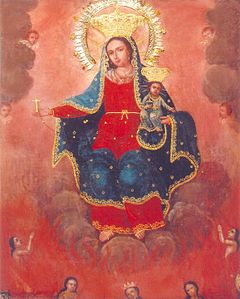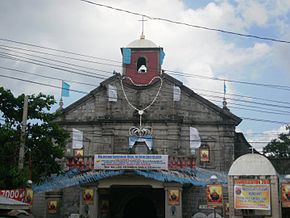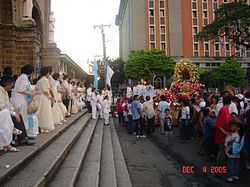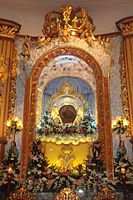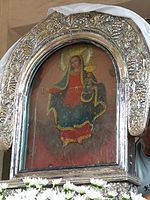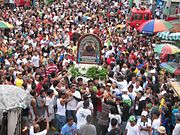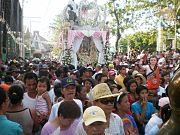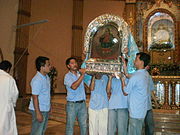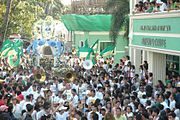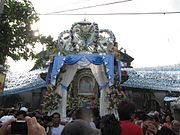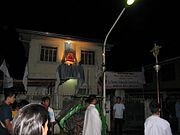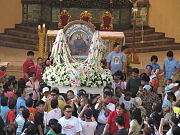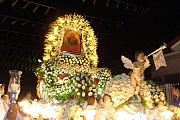- Nuestra Señora Virgen del Santissimo Rosario, Reina de Caracol
-
Nuestra Señora Virgen del Santissimo Rosario, Reina de Caracol, (Our Lady of the Most Holy Rosary, Queen of the Caracol) also called "La Reina de Caracol" or "Mahal na Birhen ng Santo Rosaryo" is the patroness of Rosario "Salinas", Cavite, Philippines.
Contents
Description
The Blessed Virgin Mary is depicted as Our Lady of the Most Holy Rosary. The Virgin, in blue and red clothes, seems to be sitting on clouds above what seems to be purgatory. In her left arm, she carries the Infant Jesus and in her left hand, the cross of a 15 decade Rosary. The Infant Jesus is garbed in a light blue attire. In his right hand he holds a globe with a cross on top symbolizing his role as protector of the earth. In his right left hand he holds one end of the Rosary.
The icon of the Nuestra Señora Virgen del Santissimo Rosario, Reina de Caracol is painted on canvas and framed in wood with silver adournments of grapes and vines. The painting is presently set with gold accouterments. The most venerated icon of Nuestra Señora Virgen del Santissimo Rosario, Reina de Caracol is enthroned at the altar of the Parish of The Most Holy Rosary in the town of Rosario.
History
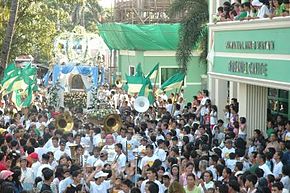 The image of the Nuestra Señora Virgen del Santissimo Rosario, Reina de Caracol and the Municipal Hall building of Rosario, Cavite
The image of the Nuestra Señora Virgen del Santissimo Rosario, Reina de Caracol and the Municipal Hall building of Rosario, Cavite
Rosario is a town in the province of Cavite, on the shore of Manila bay. Once, it was simply a barrio of San Francisco de Malabon (now General Trias). It was then called Salinas-Marsella, after the salt-mining industry. Marsella on the other hand comes from the Spanish word ‘’mar’’ (sea). It was named so because of its proximity to the sea.[citation needed] However, before the twilight of the Spanish era its name was changed to Rosario in honor of the ‘’Virgen del Rosario de Caracol’’ which was the patroness of the place. How this virgin came to our town nobody can tell the exact details. A plausible was told by one of the most respected couple of Rosario – Don Catalino Abueg and Dona Rosa Ner as to how the virgin came to our town.
During the Spanish regime, one of the best means of transportation was by boat. Cargoes from the south were brought to Manila by big boats, and there were many ‘’batel’’ (fishing boats) in Manila bay. Many years ago, in a date which remained unremembered a strong typhoon visited Manila. It caused great destruction of life and properties especially to those who lived along the coastal area of Manila bay. Countless fishermen as well as merchants were caught by the turbulent wind in the midst of the sea. One of these boats coming from Mindoro was loaded with merchandise. The furious wind and the terrifying lashes of rain hit the boat. The waves were in their wildest moments. Thus water started to fill the boat to the point that it was almost sinking. The crewmen of the boat filled with terror as death approaches tied themselves to the boat to assure themselves that they won’t get lost. The head of the crew went inside the cabin to check whatever goods they could save. As he move around, he noticed a framed image of the Lady of the Most Holy Rosary hanging on a post. A strong wind rocked the boat that made the frame swing to the point of almost being dropped in the water. The sight of the image gave him a little light of hope for safety. He beg the virgin to spare his life and that of his companions with the promise that they would build a chapel in her honor as soon as they landed on the shore. The Virgin must have heard his prayers for they were all saved.
The stormy night was followed by a serene and sunny morning. They found themselves along the shore of “Mojon’’ presently called Muzon, a sitio of the barrio of Salinas-Marsella. With great joy and gratitude, they had a chapel built on a ground which was said to belong to a certain teniente Felix Suasa. The makeshift chapel was made of bamboo and the lumber use for the altar of the Virgin was from their very own boat. It is said that there was a great feasting for the affair. The image was entrusted by the crewmen to the people of the place. The crew of the boat left, however, they left a legacy which became an undying tradition- our town fiesta in honor of the Virgin of the Most Holy Rosary. It is also said that after sometime, the people felt that they should give a more beautiful and bigger abode for the Virgin. Hence, from Muzon, the shrine was transferred to the present site of our parish and a more decent chapel was built.
Historically speaking there is still no exact data or record as to when she became the patroness of Rosario. On April 21, 1984 Mr. Tony Nazareno, the president of the Antique Dealers Association of the Philippines came to examine the Virgin. According to him, the image is a product of a Filipino brush. The face of Our Lady of the Most Holy Rosary is very Filipina. A very rare piece in the Philippine Iconography. He said that the style of the painting belongs to a well known painter – ‘’Faustino Quiotang’’. It is interesting to note that unlike so many icons of Mary, the patroness was not of foreign origin but really the Philippines' own. Mr. Nazareno posits that our Virgin was painted sometime between 1810 to 1820.
The parish and the town of Rosario was established on October 22, 1845, it was promulgated by governor general Don Narciso Claveria.
Devotion
The fiesta of Rosario includes the "Caracol" (prayer through dancing or "pasayaw na pananalangin"). During the ‘’visperas’’ of the fiesta, the Virgin is bore on the shoulders of her devotees. The arch where the Virgin is attached is heavily decorated with flowers. The vast majority of those who participate in the ‘’Caracol’’ dance to the tune of ‘’Pandanggo’’. Brass bands from neighboring towns are hired to provide music and life. From the church, the Virgin is brought to the sea in a very slow movement like a snail (this is the origin of the word ‘’caracol’’). To add color to the procession, banners of the different ’’basnig’’ participate in the caracol are so displayed. Once it is at the seashore, the Virgin is boarded in a big fishing boat. From Barangay Wawa, it is brought to Barangay Muzon where it lands. While in the sea, hundreds of fishing boats go around the Marian boat. From Muzon, the Virgin is once again brought to the church. This ‘’Caracol’’ caught the attention of the committee on the Marian celebration in Intramuros. Thus, in December 1982, the Virgin and the people of Rosario were invited to participate in the Marian celebration in Intramuros. People applauded as the Virgin and her devotees danced to the joyful tune of the “Pandanggo”. Even the Apostolic Nuncio to the Philippines that time, the Most Reverend Bruno Torpigiliani, D. D. was deeply touched by the scene. Hence, he commenced that this was the first time he witnessed such a deep and strong filial devotion to the Blessed Mother.
The feast is celebrated twice a year, one in the month of May held during the second Sunday of the month. But in some instances, it is moved to the third Sunday because of its nearness to the fiesta of San Isidro Labrador which is the patron of brgy. Ligtong.[clarification needed] And one on October 7 to commemorate the feast of Our Lady of the Most Holy Rosary.
The Confradia dela Nuestra Senora del Santissimo Rosario, Reina de Caracol (Kapisanan ng Mahal na Birhen ng Santo Rosario) was created; it is a church organization dedicated to the Patroness.
The Devotion Continues
The devotion of "Salinians" to the Nuestra Señora Virgen del Santissimo Rosario, Reina de Caracol is apparent no matter where they may be throughout the world. Natives of Rosario continue the tradition of celebrating the feast of Our Lady as they did as a child in their native Rosario. Many organizations in the United States are dedicated not only to preserving the rich culture of their hometown, preserving the camaraderie amongst their towns people, but ultimately, continuing the devotion to the Nuestra Señora Virgen del Santissimo Rosario, Reina de Caracol by celebrating a feast every October.
Organizations:
- Salinas Association of California, Inc. - San Diego
- Rosario (Salinas) Association of Greater Los Angeles, Inc.
- The Salinians of Nothern California, Inc.
Hymn
Maria Reyna ng Rosaryo
Maria Birheng Reyna ng Rosaryo,
Hiwaga ng Diyos, kami ay dinggin mo.
Itong Salinas, tingnan at utusan ang bawat nilalang.
Awit ng gloria, dangal, oh Salinas,
Lagi mong awitan ang Ina ni Jesus,
Na aming Reyna, sa kanya na tunay na nagmamahal.Mary Queen of the Rosary
Mary Virgin Queen of the Rosary,
Mystery of God, hear us all.
This Salinas, look and command each of one of us.
Hymn of glory, honor, oh Salinas,
Always sing to the Mother of Jesus our Queen, in her whom we are truly loved.
'Fiesta Hymn written and composed by Rev Fr. Francis Barcelo, former Asst, Parish Priest'O, Maria, aming Ina
Patrona ng aming bayan
Aming patnubay, aming sandigan
Sa lahat ng panahon
Ang iyong kadalisayan
Ang huwaran ng aming buhay
O, Maria aming Reyna, di ka namin iwawalay
O, Maria ng Salinas, buhay namin sayo kailanmanPhotos of the Nuestra Señora Virgen del Santissimo Rosario, Reina de Caracol Altar of La Reina de Caracol during the October 2011 Fiesta in Rosrio, Cavite.The image is placed atop her carozza in preparation for a procession.La Reina de Caracol's enthronement, October 2011 Fiesta in Rosario, Cavite.The image of Nuestra Señora Vírgen del Santíssímo Rosarío, Reína de Caracol as she is brought back to church after an entire day of "Caracol" around the town of Rosario "Salinas", Cavite.La Reina Caracol, May 2010 Fiesta in Rosario, Cavite.Members of the Knights of Columbus Council 7868 present the image to the faithful of Rosario prior to her enthronement. The Knights have been one of the greatest devotees of the Patroness, often spearheading the task of decorating the church each fiesta and serving as marshalls during caracols and processions. They also have a council choir which sings during Sunday mass. The council is named after their beloved Patroness.La Reina de Caracol, October 2011 Fiesta in Rosario, Cavite.The image of the Nuestra Señora Virgen del Santissimo Rosario, Reina de Caracol and the Municipal Hall building of Rosario, Cavite.The image of the Nuestra Señora Virgen del Santissimo Rosario, Reina de Caracol, Patroness of Rosario "Salinas", Cavite on her Feast Day at the start of the "Caracol".A devotee's devotion. A replica of the Virgin is displayed on the balcony of a faithful devotee in union with the procession of the original image that will pass by the "camarera's" residence.View of the back of the Virgin. Devotees have access to the back of the altar where than can pray and visit with the image. Devotees tend to touch the garb draped on the back of the image as a sign of reverence.Salinians of Greater Los Angeles dance the Caracol during the October 2010 Fiesta in Rancho Cucamonga, CA.Immediately following mass, the caracol starts from inside the church. A replica of the original image is used during the caracol.La Reina de Caracol in procession.References
Wikimedia Foundation. 2010.

